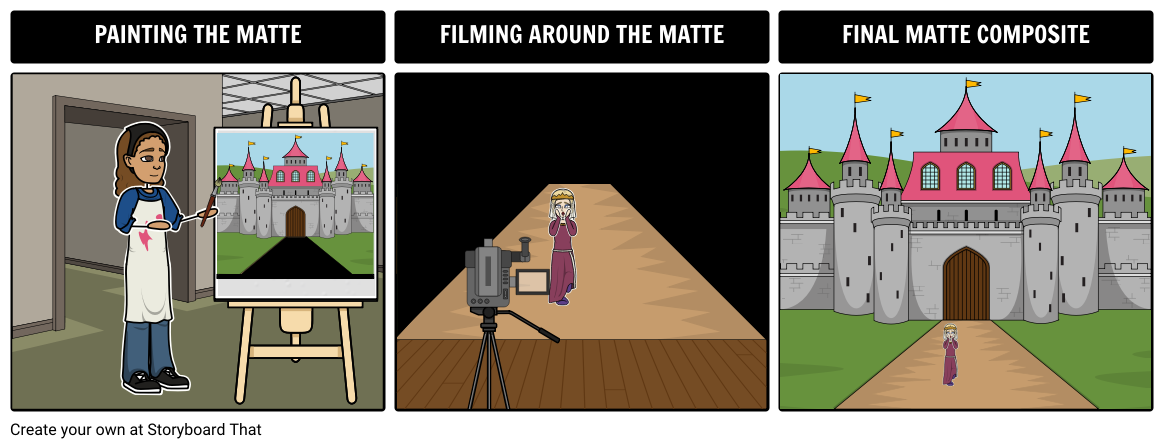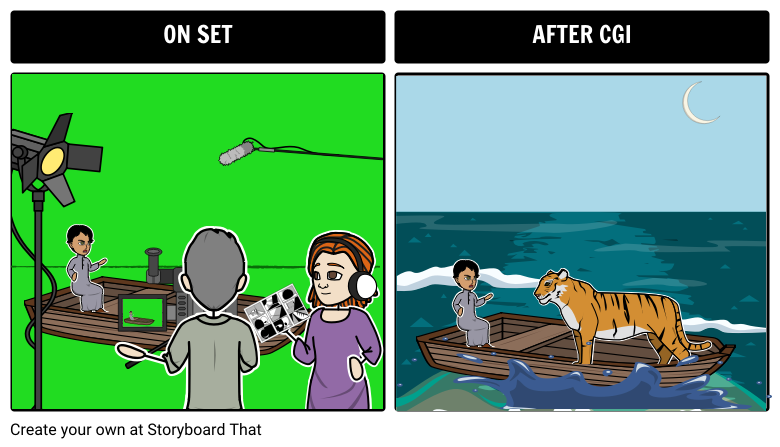how to make special effects in movies
The 6 Effects

From the very beginning of the creative process, imagination is in play. Before a thing exists, it must be visualized in the mind. This happens in filmmaking all along the way. First the screenplay must be written, a necessary text exercise which does not allow for initial images. Then comes the storyboard. At this point, the first spark of what lies inside the artist's mind comes to life. Sequences are graphically plotted out, providing key frames to the movie's progress. It's a revelation to register this with the eyes for the first time. After production gets into swing, it all gets real. A director must review props and wardrobe, audition and cast actors, scout and approve locations, and so forth. When that hot moment finally arrives – filming on set – you're seeing your scenes once and for all, right? Well, not quite…
VFX. Enter the very broad area of Special Visual Effects. Deep into film's history, various techniques have been employed to insert imagery which was not filmed on set with things which were. The present and the not-yet-here will eventually share the screen. These days, it's common knowledge that there's a little CGI (Computer Generated Imagery) in almost every Hollywood movie out there. But as far back as the 1890s, filmmakers were using clever methods to add elements to films via in-camera tricks, clever editing, and double exposures. Despite the fact that the digital age has made many of these traditional techniques much less common, virtually all of them are still in use today.
Regardless of how special visual effects are accomplished, one central challenge has always been consistently presented to filmmakers: how can a scene be filmed when much of it cannot be seen at all? Again – digital film has narrowed this challenge to a great degree. But ultimately, actors need to play against characters and events which are not happening. The camera must record a negative space it does not yet know. And as always, the director must always be cognizant of what the final edited scene will look like, this time with nothing on set to look at. There's a lot of ways to do this, but it varies depending on the techniques being employed. Below are some of the more common visual effects used in live action feature films, and how the filmmaker can approach mastering the art of "see you later."
1. Animation
There's a great deal of famous examples of films which have animated characters interacting with the "real" world in the movie. Classic examples include Disney films like Mary Poppins and Who Framed Roger Rabbit? Hand-drawn animated people and animals were added after the fact, while actors would have to play against props standing in for living counterparts. More recently, CGI has been used to fulfill this function, such as in The Life of Pi and Goosebumps. The good news for the filmmakers is that a well-crafted storyboard will serve as a guide in pre-production to get cast and crew familiar with the idea of what the final frames and sequences will look like. When combined with character illustrations and production design renderings, a full picture can be grasped to help translate not only the action, but the mood of what will be added in later. Voice actors can also be present on set to add an aural element which can be especially beneficial to the people giving their lines on set.
2. Miniatures
One of the oldest tricks in the special visual effects book is the use of miniatures. Traditionally, this meant building scale models of environments to represent very large sets like entire cities, massive vehicles, huge structures, and so forth. As far back as the Silent Era, films like Metropolis used miniatures to represent a city of the future, complete with moving parts. Actors would have to look out at nothing and try and make us believe they were beholding a jaw-dropping scenario. While the first look at miniatures occurs in the storyboard, it's in the production design process that filmmakers get the first real look at the details of the models to be built. Once the craftsmen get down to the business of building them, the whole crew can have a real look at what will be appearing on screen. While not every production can have access to completed miniatures prior to filming on set, even early examples should be shared with key production staff and cast. There's a tactile element to standing in front of finely constructed miniatures which really sinks into the eyeballs. You can even really touch them (carefully!). Getting face time with what will sit in on screen later will benefit the production.
Giant Monster Miniature

3. Matte Paintings
Another time-honored method to add large-scale environments is the Matte Painting. There's a few different ways to do it, but essentially, an artist paints a highly detailed photo-realistic set piece, often on a massive scale, to depict what a set could not. Actors are blocked into the frame so as to not break the borders of the matte which will be added later. The Wizard of Oz employed them to great effect, especially when Dorothy and the gang get their first look of The Emerald City in the distance. Star Wars also used them in shots like the Death Star's loading bay – those hundreds of Storm Troopers were literally drawn in! Storyboards are often key to the initial understanding of how these frames will look when the images are integrated, but that all becomes much more clear with production design. In the past, these specialized paintings might not be ready to be seen by the time cameras roll on set. These days, digital mattes are the most common, and early access to the visuals can get the whole crew on the same page.
Matte

4. Stop Motion
There's a certain charm to stop motion animation, even if the final product cannot mask what it is. From old classics like King Kong to 2015's Oscar-Nominated Anomalisa, there's a texture to exposing fully posable models one frame at a time that CGI can never recreate. Figures such as dolls, toy vehicles, clay, or just about any raw material a filmmaker may wish to animate are painstakingly filmed in dozens of poses per second of film in order to recreate the illusion of motion. Early test trials can give cast and crew a very concrete idea of what will be appearing next to them on screen in post-production, offering a grounding experience where before they faced only a blank space on set. Filmmakers can prepare the production even earlier by sharing storyboards and character design in advance of the stop motion photography. And since it's common for stop motion techniques to also employ mattes, miniatures, and even animation, a much deeper source of reference is often available to prep everyone involved for their part in the final product.
5. Doubling
Everybody seems to love twins. And clones. Or maybe robots with a striking resemblance to a protagonist. Whatever the case, every time you see a double of a character on screen, it is almost invariably the technique of doubling which you are watching (as opposed to using real-life twins, triplets, etc.). And in the digital age, doubling can easily go haywire, the way Agent Smith's multiple avatars seem to be endlessly multiplying in the Matrix films. Doubling puts the burden squarely upon the actor: how does one play against oneself? Early on in pre-production, a storyboard can help a cast devise a physical strategy for expressing the juxtapositions of its various selves. In the past, previously-recorded dialogue or an actor providing countering dialogue made for great assistance to the actor doubling their part. The digital age allows for instantaneous replay and integration of doubled actors, so they can literally watch themselves act against themselves right there on set if need be. But as always, doing early tests with the tech on hand can do an even better job on performance prep.
Doubling

6. CGI
The most talked-about special visual effect is also the one that people don't seem to appreciate the depths of enough. Computer Generated Imagery can literally put anything up on a screen – from vast landscapes that don't even exist to huge armies filled with digital people instead of extras on set. Digital tech allows scenes to be literally painted and animated in any way the filmmaker chooses. And, if so desired, can replace every other form of effect discussed here so far. Even so, there are many reasons to still use miniatures, mattes, and models, and so often CGI is mixed in with other media to make film sequences. What's also nice about the process is that the "missing" elements can often be interacted with on set via an integrated composite on a monitor. This gives cast and crew an enormous advantage when filling in the gaps missing in front of the camera. But before that even happens, the filmmaker must be very sure to ask for what they want. CGI is an expensive process requiring great expertise and a large technical crew operating expensive software and hardware. While there is the luxury of "erasing" results one does not like, there are enormous cost overruns at risk when making such mistakes. Better to use cheaper methods earlier. Tools like storyboards, production design, and test clips should never be disposed of, even if digital composites will be available on set. Getting everything right from the get-go can save filmmakers a lot of time, money, and headaches.
CGI

There are many other sorts of visual effects, but those are generally integral to set pieces. Things like explosions, makeup, camera tricks and so forth don't require the same kind of prep techniques we've discussed here. There is so much a filmmaker can't hope to see until they get into the post-production process, the pressure can really mount to both maintain the vision in one's head and effectively communicate that vision. When it comes to Special Visual Effects, taking extra steps to provide a tangible way to "see" a scene well before it's done is hugely important. No amount of post-production alchemy can substitute a live experience for cast and crew. We filmmakers are, after all, only human!
About the Author

Argentinean-born New Yorker Miguel Cima is a veteran of the film, television, and music industries. An accomplished writer, filmmaker, and comic book creator, Miguel's movie, Dig Comics, won Best Documentary at the San Diego Comic Con and was selected for Cannes. He has worked for Warner Bros. Records, Dreamworks, MTV, and more. Currently, Miguel creates content for multiple platforms and media. His formal education came from New York University, where he earned a BFA in film. World traveler, culture junkie and major foodie, he is happily unmarried to the same gal since the mid 2000s, devoted to his family & friends, and slavishly serves his true masters - two dogs and a cat.
how to make special effects in movies
Source: https://www.storyboardthat.com/articles/f/special-effects
Posted by: hernandezouldives.blogspot.com

0 Response to "how to make special effects in movies"
Post a Comment